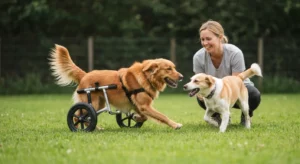A new wave of artificial intelligence is moving beyond human language and into the complex world of barks, meows, and body language, offering unprecedented insights into the inner lives of animals. In 2025, a confluence of sophisticated machine learning algorithms, advanced sensors, and massive datasets is enabling scientists, veterinarians, and even everyday pet owners to decode animal behavior with remarkable accuracy, heralding a potential revolution in pet care, animal welfare, and conservation.
From AI-powered collars that predict illness before symptoms appear to systems that translate the emotional content of a dog’s bark, this technology is rapidly moving from research labs into the mainstream. While proponents celebrate a future of deeper understanding and proactive care, some experts urge caution, highlighting concerns about accuracy, over-reliance on technology, and the potential for it to interfere with the fundamental human-animal bond.
From Wearables to Vocalizations: The New Frontier
At the heart of this technological shift is machine learning, a subset of AI where systems are “trained” on vast quantities of data to recognize patterns. In the context of animal behavior, this data can be anything from the sound of a cat’s purr to the subtle movements of a dog’s ears or the gait of a horse.
“We are essentially building digital interpreters for the non-verbal world,” explains Dr. Ben Carter, Chief AI Officer at the tech startup Ani-Logics, a company specializing in bio-acoustic analysis. “Our models are trained on tens of thousands of hours of audio and video, each segment meticulously labeled by veterinary behaviorists. The AI learns to associate a specific vocal frequency, a tail posture, or a pattern of scratching with a known state like anxiety, playfulness, or even the early onset of a skin condition.”
This technology is manifesting in several key areas:
- Smart Wearables: Collars and harnesses equipped with accelerometers, GPS, and biometric sensors are becoming increasingly sophisticated. They no longer just track steps; they monitor heart rate variability, respiration, sleep quality, and specific behaviors like scratching, shaking, and drinking. An AI model analyzes this continuous stream of data to establish a baseline for an individual pet and flag anomalies that could indicate pain, stress, or disease.
- Acoustic Monitoring: Devices and smartphone apps are now equipped with AI that can analyze animal vocalizations. A landmark 2025 study from the University of California, Davis, demonstrated that an AI model could distinguish between playful and aggressive dog barks with 92% accuracy. Similar technology is being developed to interpret the urgency and potential cause of cat meows, differentiating between a call for food and a cry of distress.
- Computer Vision: Strategically placed cameras powered by AI can monitor pets at home, in veterinary clinics, or in shelters. These systems use computer vision to analyze body language—such as ear position, tail carriage, and overall posture—to assess an animal’s emotional state. This is particularly valuable in multi-pet households for identifying the subtle instigators of conflict.
The Data: A Market Responding to Demand
The consumer appetite for these high-tech tools is growing at an explosive rate. According to a 2025 report by Global Pet Tech Insights, the market for AI-powered pet monitoring devices is projected to reach $5 billion by 2028, a staggering increase from just $1.2 billion in 2023. The report surveyed over 3,000 pet owners and found that the primary driver for adoption was “peace of mind.”
The survey revealed that 78% of owners of AI-enabled devices felt more connected to their pets, while 65% believed the technology helped them identify a potential health issue before they would have noticed it otherwise. This data suggests a fundamental shift in how people approach pet wellness, moving from a reactive to a proactive model of care.
Practical Applications in Health and Welfare
For veterinarians, the rise of animal behavior and AI integration represents a paradigm shift from subjective reporting to objective data analysis.
“An owner might tell me their cat is ‘just not herself,’ which is a crucial starting point, but it’s subjective,” says Dr. Lena Petrova, a veterinarian at the Metropolitan Animal Hospital in Chicago. “Now, they can come to me with a report from their pet’s smart collar showing that the cat’s deep sleep periods have decreased by 30% and its visits to the litter box have doubled. That is hard, actionable data that can point me directly toward potential urinary tract or kidney issues. It’s a game-changer for early diagnosis, especially in species like cats that are masters at hiding pain.”
Beyond the Home: AI in Conservation and Shelters
The application of this technology extends far beyond domestic pets. Conservationists are deploying AI to protect endangered species and understand complex ecosystems. Drones equipped with AI-powered cameras can count animal populations in remote areas, while underwater hydrophones use machine learning to analyze whale songs, tracking migration patterns and monitoring the health of pods.
In animal shelters, a notoriously high-stress environment, AI is being used to improve welfare. “AI-driven monitoring helps us triage care more effectively,” states Maria Flores, Director of Animal Welfare at the Global Humane Society. “Systems can analyze kennel activity to identify animals exhibiting high levels of stress, like persistent pacing or hiding. This allows our staff to intervene immediately with enrichment activities, quiet time, or a veterinary check-up. An animal that is less stressed is healthier, happier, and ultimately more adoptable.”
The Unspoken Concerns: A Call for Cautious Optimism
Despite the immense promise, the rapid proliferation of AI in the animal world is not without its critics and concerns. The primary debate centers on accuracy, ethics, and the very nature of the human-animal relationship.
Dr. Samuel Jones, a renowned ethologist and author of the book The Canine Connection, represents a more skeptical viewpoint. “The promise of an animal ‘translator’ is seductive, but it’s a dangerous oversimplification,” he argues. “Behavior is context-dependent. A tail wag isn’t just a wag; its meaning changes with its height, speed, and the rest of the dog’s body language. While an AI can learn to label patterns, it lacks genuine comprehension of that context.”
His primary concern is that a reliance on technology could erode the intuitive skills that humans have developed over millennia of living with animals.
“My fear is that people will start watching a screen instead of watching their dog,” Dr. Jones adds. “They’ll trust an app’s ‘anxious’ alert over their own gut feeling. This technology should be, at best, a supplement to, not a substitute for, direct observation and the deep, nuanced bond that comes from spending quality time with an animal.”
Other concerns include:
- Data Privacy: Who owns the vast amounts of data collected by these devices? The information about a pet’s behavior and a home’s daily routine could be valuable to marketers and other third parties.
- Algorithmic Bias: AI models are only as good as the data they are trained on. If a model is trained primarily on Labradors, its ability to accurately interpret the behavior of a Shiba Inu or a Greyhound may be significantly compromised, potentially leading to misinterpretations.
– Accessibility and Equity: With premium devices costing hundreds of dollars plus subscription fees, there is a risk of creating a two-tiered system of pet care, where only affluent owners can afford the benefits of proactive AI monitoring.
The Future of Interspecies Communication
The integration of animal behavior and AI is still in its infancy, yet its trajectory suggests a future where the communication gap between humans and other species may narrow significantly. The goal for many researchers is not just to monitor, but to understand. Scientists are already exploring two-way communication systems, where an AI could not only interpret an animal’s signal but also generate a response—a sound or a visual cue—that the animal can understand.
As the technology matures and its limitations are better understood, the key will be to strike a balance. AI offers a powerful new lens through which to view the animal world, providing objective data that can enhance health and welfare. However, experts on all sides of the issue agree that this technology must be used to augment, not replace, the empathy, intuition, and shared experience that form the bedrock of the human-animal bond.











